Rupert Matthews's Blog, page 9
May 30, 2020
Gladiators vs Animals in Ancient Rome
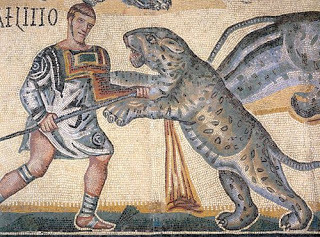 The first wild animal show was to celebrate a military victory
The first wild animal show was to celebrate a military victory In 164bc Rome defeated the powerful North African city of Carthage. The victorious general, Publius Cornelius Scipio, gained the nickname Africanus. He brought back to Rome hundreds of African animals, such as elephants, crocodiles and lions. After parading the animals through the streets, he included them in his gladiatorial games.
One elephant hunt went badly wrong
In 79BC the general Gnaeus Pompey staged a wild elephant hunt with 20 elephants in a temporary arena in Rome. The crowd was protected by a tall iron fence, but two of the elephants charged at the fence, smashing it down. They were quickly killed by hunters, but several people had been injured.
The design of the arena changed to allow wild animal hunts
As the wild animal hunts, or venationes, became more popular the need to keep the watching crowd safe meant changes to the arena had to be made. The arena was sunk about 3 metres into the ground and surrounded by a vertical wall of smooth stone. No animal could leap up the wall or break it down, so the spectators were safe from attack.
Some animal shows were utterly bizarre
The Romans loved to see animals fighting each other. Sometimes a group of lions or wolves would be set to attack zebras or deer. At other times two hunters would be set to fight each other. They were often chained together to encourage them to fight. Some pairings were very odd. A snake was set against a lion, a seal set to fight a wolf or a bull against a bear.
Lions were set to fight tigers
One of the most popular animal fights was when a lion was set against a tiger. So many lions and tigers were sent to Rome to die in the venationes that they became extinct in some areas of North Africa and the Middle East.
I Don’t Believe It
The Romans loved watching animals that had been trained to perform tricks. One famous animal trainer put on shows in which an ape drove a chariot pulled by camels.

Published on May 30, 2020 06:45
Polynesian Warfare
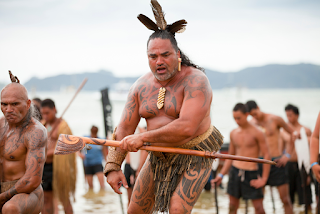 Polynesians fought without armour or shields. The hundreds of islands scattered across the Pacific were home to people of the Polynesian culture. These people had no metal and so made their weapons from wood, stone and other natural mateirals. They preferred to rely on skill and movement in battle rather than on shields or armour, though some men wore thick shirts of plaited coconut fibres as protection.
Polynesians fought without armour or shields. The hundreds of islands scattered across the Pacific were home to people of the Polynesian culture. These people had no metal and so made their weapons from wood, stone and other natural mateirals. They preferred to rely on skill and movement in battle rather than on shields or armour, though some men wore thick shirts of plaited coconut fibres as protection. War clubs were favourite weapons. Wooden clubs were carved from single pieces of wood about 1.2 metre long. They had wide, heavy heads that were often elaborately carved with geometric shapes and patterns.
The Maori used wooden weapons. The Maori are the Polynesian people who live in New Zealand. They produced unique types of club. The mere, for instance, had a short handle and a wide curved blade that could be used for slashing at the enemy.
Shark teeth were made into swords. In western Polynesia shark teeth were added to the sides of long clubs to produce a weapon called the tebutje. This could be used to cut as well as smash and was deadly at short range.
Warriors travelled in war canoes. Because the Polynesians lived on islands separated by wide stretches of ocean they used canoes to travel. Warriors had special war canoes that were wider and much longer than usual canoes. They could be rowed quickly by the warriors on board and were often decorated with carvings of the gods.
I Don’t Believe It!
Warriors in Fiji used a club shaped like a pineapple.

Published on May 30, 2020 06:43
An Eventful RAF Raid on Berlin 1943
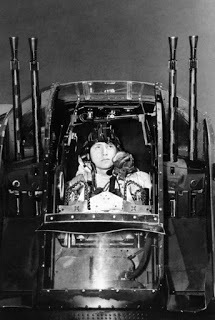
One eventful sortie to Berlin in February was undertaken by the crew of Flight Lieutenant Thomas Blackham of No.50 Squadron.
Over western Germany the bomber was subjected to anti aircraft fire that came without searchlights, and was presumably aimed by radar. One shell damaged the elevators, but the bomber was otherwise untouched. A few minutes later a nightfighter that nobody on the Lancaster ever saw opened fire and bullets riddled the rear part of the bomber. The rear turret was put out of action, though the gunner was uninjured, and numerous holes punched through the fuselage. Though nobody on board at the time realised it, the oxygen equipment had also been damaged. Believing the damage to be slight, Blackham chose to push on to Berlin.
As Blackham began his bombing run he began to feel light-headed and called up the rear gunner to see how he was, but there was no answer. Two other members of the crew also failed to respond to Blackham’s increasingly worried calls. The bombaimer, however, continued to give the calm directions necessary, so Blackham pushed on to drop his bombs. Once the deadly load had gone he asked the flight engineer to investigate and the damage to the oxygen was discovered. The flight engineer effected a hurried repair and soon the unconscious crew members were awake once more. The return trip was uneventful and three nights later the crew went out again, this time to Augsburg.
Photo shows : tailgunner on a Lancaster

Published on May 30, 2020 06:39
The First Uses of Gas in World War I.
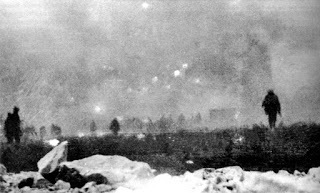 The Hague Treaty of 1899 had specifically banned the use of poisonous gas in warfare. Despite this the weapon was to be used by both sides during the First World War, usually with horrific results for those struck but for little actual battlefield gain.
The Hague Treaty of 1899 had specifically banned the use of poisonous gas in warfare. Despite this the weapon was to be used by both sides during the First World War, usually with horrific results for those struck but for little actual battlefield gain. Signed in 1899 by most European nations, the Hague Convention laid down many rules for the conduct of war, treatment of prisoners and other matters. At the time it was widely believed that poisonous gas of all types had been banned. However, the actual wording of the relevant clause stated “The Contracting Powers agree to abstain from the use of projectiles the object of which is the diffusion of asphyxiating or deleterious gases.” That wording would come to be important as soon as the First World War broke out.
It was the French who first used gas. In the fighting that took place in Alsace in August 1914, the French preceded their attacks on prepared German defenses with hand grenades containing an ethyl-based tear gas. The grenades proved to be so ineffective that the Germans did not even notice them. The use of the gas was renewed in November with only slightly better results. The Germans retaliated in October against British positions near Ypres, but again the gas had little effect.
The Germans believed that the tear gas had not worked as it had been used in small quantities. On 31 January 1915 a total of 18,000 shells containing tear gas were fired at Russian lines near Warsaw. This huge concentration failed to have any effect as the weather was so cold that the gas froze solid in puddles on the ground.
Meanwhile the Germans had been stockpiling deadly chlorine gas. On 22 April 1915 a total of 150 tons of chlorine gas in 5,700 cylinders was distributed to German units along the trenches facing Ypres. Starting at 5pm the Germans with the cylinders opened the valves and pushed the cylinders over the top of their trenches into no man’s land. The grey-green gas spurted out, formed a large cloud and was carried toward the Allied lines by a gentle east breeze.
First to be struck by the gas was a division of French Algerian troops. As men began to fall dead and others began clawing at their throats in agony the rest turned and fled. They were swiftly followed by a Senegalese unit and regular French regiments. A stretch of trenches over 8,000 yards wide was simply abandoned as the men fled the gas. To the north a Canadian division was struck by the edges of the deadly cloud. Some men fled, others ran only so far as nearby trenches where the gas did not reach. Confusion spread.
At 5.50 the fleeing men reached the town of Ypres, ten minutes later the gas followed them. By now the gas was dissipating, but it could still be fatal. An officer in the Durham Light Infantry who had been a chemist before the war recognized the smell and ordered his men to urinated into handkerchiefs and wrap them around their faces – the ammonia in the urine blocked the chlorine. He led his men forward into the gas to find the trenches empty.
Meanwhile, the German infantry were refusing to advance until the foul, deadly gas had dissipated. Chlorine gas is heavier than air, so it lurked in the abandoned French trenches long after it was blown away on the surface. The Canadians were meanwhile hurrying south to take over machine guns abandoned by the French and to jump into the trenches that were clear of gas. By the time a German attack was sent in, it was too late.
Photo shows :
British infantry advancing through gas at Loos, 25 September 1915

Published on May 30, 2020 06:35
May 28, 2020
BOOK REVIEW - Mostly Harmless by Douglas Adams
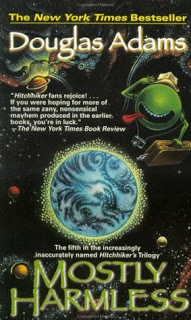
Douglas Adams was clearly back on form with this fifth and final book in the trilogy - after what I found to be the deeply disappointing fourth volume.
Most of the regular characters are back, plus a number of new ones. The quirky situations are just as quirky as they were and the one-off characters are funny, humorous and imaginative - and odd. So this is much more like the Hitchhiker concept. As with Book 3, however, there is much less dialogue than before and a lot of descriptive writing. That is fine, but I really did like the dialogue-driven style of the first two books.
I must confess that I found the storyline rather bleak - especially towards the end. I won't give away the surprise ending, but the novel does not end in a happy place. I was not sure how I felt about this. It seemed a shame, given that the novels are very funny, but on the other hand I suppose it served to throw into high relief the underlying humour of the rest of the books.

Published on May 28, 2020 08:25
Barbara and the Blitz - English Comprehension, History and Art. Key Stage 2
Barbara and the Blitz
During World War 2, Barbara lived with her Mummy, Daddy and elder sister in a village called Abbots Langley. The village is several miles north of London.
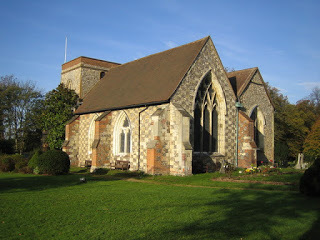
Here is a picture of the church at Abbots Langley. Barbara used to go to this church on Sundays.
Barbara’s father was a printer. He worked at a factory printing leaflets and posters for the government. Barbara’s mother was a school teacher. Barbara and her sister were both at secondary school in a nearby town called Watford.
In 1939 Britain went to war with Germany. By the autumn of the year 1940 the Germans had defeated nearly every country in Europe – except Italy which was friends with Germany. Only Britain was left.
The Germans sent aircraft to drop bombs on Britain to try to make Britain surrender. The Germans dropped bombs on factories that made weapons for the British Army. They dropped bombs on ships that were bringing food to Britain. They dropped bombs on the ports where the ships unloaded the food. They dropped bombs on railways that carried food to towns and villages, like Abbots Langley where Barbara lived. The Germans thought that if everyone was hungry that Britain would surrender.
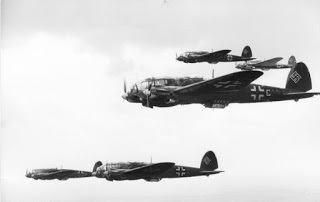
German bombers flying to attack Britain. Note the big black crosses on the aircraft.
Sometimes a German bomber aircraft would get lost. It might bomb the wrong thing. Instead of a factory it might drop bombs on a big building such as a hospital or a church. From high up in the sky one big building looks like another.
Several nights the German bombers would fly over Abbots Langley on their way to attack a factory somewhere. Barbara and her family had to go to the bomb shelter to hide in case a bomber dropped its bombs on Abbots Langley by mistake.
One evening as Barbara and her sister were about to go to bed, the neighbour knocked on the door. He spoke to Barbara’s father. He said that there was something very strange outside. Everyone went outside. The neighbour pointed up into the sky.
“Look,” he said. “That looks like a big, red sunset. But the sun set over two hours ago.”
“Yes,” said Barbara’s father. “And the sun sets in the west. But that big red glow is in the south. Whatever can it be?”
“Let’s go and look,” said Barbara’s mother.
They left the garden through the gate into the fields. They walked across a field and up a hill. They were walking south, towards the strange red glow in the sky. They began to hear strange noises.
When they reached to top of the hill, they all stopped. From the top of the hill they could see London in the distance. The red glow filling the sky was caused by huge fires. The whole of London was on fire. Houses were on fire, churches were on fire, factories were on fire. The entire city was burning.
Barbara and her family could hear the sounds of aircraft engines. They could hear the sounds of bombs exploding.
Barbara’s father said “I did not think the Germans had so many aircraft.”
Barbara’s mother said “Those poor people in London.”
The neighbour said “Are the Germans going to win the war?”
They stood and watched London burn for a long time. Then they went home and went to bed.
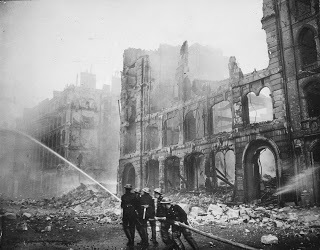
Firemen in London putting out fires the day after the attack.
Next morning, Barbara’s father switched the radio on as they ate breakfast. The radio played music, then the news came on. The news announcer said “There were heavy German bombing attacks on London last night. Many buildings were destroyed. Many people were killed. But the factories are still making weapons. The ships are still bringing us food. Prime Minister Winston Churchill is still alive. He is at work in Downing Street this morning.”
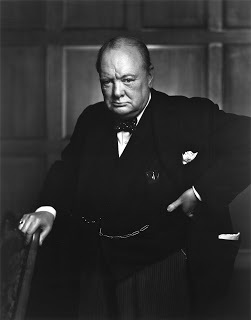
Prime Minister Winston Churchill.
Barbara’s father switched off the radio. He said “If Churchill is still alive and back at work everything will be OK. I’m going to work.” Then he looked at Barbara and her sister. He said “And you two had better go to school.”
The big attack on London is called “The Blitz”. The German bombers came back on many nights after that first big attack. That is why so many old buildings in London were destroyed.
The Germans did not win the war.
Barbara and the BlitzQuestions
1 – Where did Barbara live during the War?
2 – Was Barbara’s sister older or younger than she was?
3 – Why did the neighbour knock on Barbara’s door?
4 – which direction did Barbara and her family walk?
5 – Who was the Prime Minister of Britain during the War?
Projects
Draw a picture of a sunset
Or
Draw a picture of The Blitz. Where are the German aircraft? Where are the buildings? What colour are the flames?

Published on May 28, 2020 06:14
May 24, 2020
BOOK REVIEW - "Sanders" by Edgar Wallace
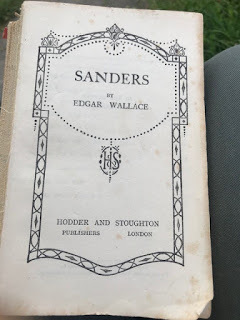 I bought this book very cheap at a fair. As you can see, it does not even have its front cover any longer. It seems the imprint page has gone as well, so I don't know quite how old this version is but looking at the back cover and title page I'm going to guess it is 1940s. I gather it was written in the 1920s. I had read some of Edgar Wallace's crime novels and liked them very much. I had also heard of the Sanders of the River series of books, so thought this was probably worth 20p - or whatever I paid for it.
I bought this book very cheap at a fair. As you can see, it does not even have its front cover any longer. It seems the imprint page has gone as well, so I don't know quite how old this version is but looking at the back cover and title page I'm going to guess it is 1940s. I gather it was written in the 1920s. I had read some of Edgar Wallace's crime novels and liked them very much. I had also heard of the Sanders of the River series of books, so thought this was probably worth 20p - or whatever I paid for it. Gosh - what to say about this book?
It was written a hundred years ago and is very much of its time. It has all the prejudices, attitudes and views of the time - which are very different from the bigotries, attitudes and views of our own time.
The action is set in an unnamed British colony in West Africa. The main heroes are the three British officials who administer the part of the colony based around a river with its peoples, problems and crimes. The title hero is Commissioner Sanders - an incorruptible and upright civilian official who collects taxes, administers justice and deals with any intruding Europeans. He is assisted by two military officers who command the locally recruited regiment. Hamilton is a competent soldier, while his junior Tibbets is what would have been termed back then "a perfect ass". Again both are honest, upright and doing their best to do what is right for the peoples of the area they look after. To modern eyes their attitudes to the locals is extremely paternalistic to the point of racism - and their notions of dispensing justice might be politely described as being "rough and ready", involving as they do summary executions without trial.
On the other hand, the white folks in the books do not come out of it very well. The Africans might be engaged in murder, robbery and such but for pure downright cold blooded evil you have to turn to the white characters.
The author spent several years in Africa as a journalist. Among the things he covered were the horrific brutalities meted out in the Congo by the Belgians. The death toll is unclear but certainly ran into the millions. The Belgians were concerned only with profit and used their superior weaponry ruthlessly to trample over what we would today term human rights and cultural sensitivities. It is probably not too much of a stretch to see the fictional Commissioner Sanders as being the author's view of what a good colonial regime should be. I suppose he was portraying the British Empire to a British audience in the idealised form that the British audience wanted the British Empire to be. Whether it was or not is another question.
Anyway, if you can get past the attitudes and views of the author and the characters he creates, these are absolutely cracking adventure tales. well drawn characters, plot twists and turns in plenty and more action than you could reasonably expect to be packed into the number of pages.

Published on May 24, 2020 05:02
May 21, 2020
The Bolo Tie and Culture Clashes in the Southwestern USA
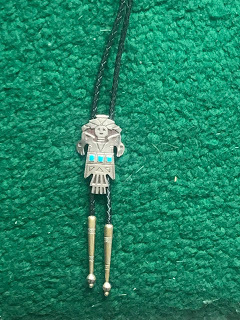
Delving back into the box of my father’s things that I found in my attic when having a Lockdown clear out, I found this thing. I remember it very clearly as my father was very proud of it and wore it often at weekends. I had no idea what it was called, however.
The plaited leather thong is about 2 feet long and ends in two silver tassels. The silver plate takes the form of a stylised dancing woman and is studded with turquoise. On the back is a double ring of silver that allows the silver plate to slide up and down the thong. Father used to wear it instead of a tie at weekends. He tucked the thong under his shirt collar, left the top button undone and had the silver plate well pushed up to sit just below the top button with the neck of the shirt slightly undone.
There are two stories linked to this object. The first is the result of research that I did to discover what it is. The second is, I think, more revealing of the clash of two very different cultures in the Southwest of the USA.
So first, what is this? It is a “bolo tie” and is considered characteristic of Cowboy wear, particularly from the states of New Mexico, Arizona and [to some extent] Texas. It can be worn informally as my father wore it, or formally with a suit or jacket in which case the shirt top button would be fastened.
According to tradition, it was invented in the 1940s by a cowboy named Victor Cedarstaff of Wickenburg, Arizona. One day he was out working the cattle when his hat blew off. Wary of losing the silver-trimmed hatband, he slipped it around his neck. His companion joked, "That's a nice-looking tie you're wearing, Vic." An idea was born! Cedarstaff spent some time experimenting with silver ornaments, hat bands and such like until he created what was to become the bolo tie. He patented the plate and loop mechanism. The name he chose is derived from the Spanish boleadora, a type of lariat.
By the 1960s the bolo tie had become fashionable in Arizona and New Mexico, and was also being purchased as souvenirs by tourists. My father got his in the early 1970s. Because Cedarstaff’s original hat band had featured a silver ornament made by local Navajo craftsmen, the bolo ties became something of a speciality for the Navajo and other local Native American peoples.
The bolo tie was made the official neckwear of Arizona in 1971. New Mexico passed a non-binding measure to designate the bolo as the state's official neckwear in 1987. On March 13, 2007, New Mexico Governor, Bill Richardson, signed into law that the bolo tie was the state’s official tie. Also in 2007, the bolo tie was named the official tie of Texas.
But back to my father. He bought his bolo tie in Taos, New Mexico, in the early 1970s when he was in the USA on a business trip. It was always eyecatching and if anyone ever commented on it, he would happily tell the tale of when and where he bought it. If the hapless listener seemed interested, father would go on to detail the conversation he had in the shop where he bought it. That tale is a fascinating story of the clash of cultures and of the sort of impact that the advent of Western Civilisation had on the local Native Americans.
According to my father, he bought his bolo tie in a store in Taos that featured a wide range of Native American [they were called “Indians” back then] crafts and products. As well as buying his bolo tie he bought some silver and turquoise jewellery for my mother and a couple of nicknacks for my sister and me. Presumably the shop was not busy as my father got chatting to the store owner.
The store owner was a white man, though a local. He told my father that he spent most of his time in the store selling to tourists, but that every now and then he went out to tour the local pueblos and other settlements to buy stock. He pre-arranged the visits so that the local craftsmen could bring the stuff they had made to sell to him.
According to the man, he had no end of difficulty with the older craftsmen. Remember this was in about 1973, so the older men would have been born not long after the year 1900. At this time the local tribes were, more or less, still leading a traditional lifestyle, worshipped their tribal deities and rarely saw white settlers in the desert lands.
These older men were, apparently, the more skilled craftsmen and could work wonders. The problem was that they valued the items that they made in terms of the skill of the work that had gone into them. They produced the most wonderful works of art, very often highly decorated versions of everyday items used by the local people in their houses or on their farms. The problem was that none of the tourists from New York or San Francisco wanted to buy a pair of painted dancing moccasins, or beautifully beaded leather tool bags. They wanted to buy bolo ties, belts and brooches.
The store keeper said that no matter how often he asked the old men to make him the sorts of objects that he could sell, they kept on making old style stuff that they valued. They simply could not understand that the tourists did not value things the same way that they did. As a result, the storekeeper would not buy things he could not sell, and the old craftsmen got very angry he would not pay for something they valued highly and had spent days making.
By contrast, he said, the younger men fully understood that the storekeeper would pay only for things that he could sell to tourists. So they came to the meetings laden down with all sorts of craftwork that were the right sort of items to sell to tourists. The storekeeper bought the lot.
That made things even worse. The old men saw the young men being paid for what they considered to be inferior quality goods. There were, the storekeeper said, some terrible arguments and once he had to call the police.
My father found this anecdote absolutely fascinating, and I think he was right to do so. He viewed this as being a prime example of culture clash between the white man and Native Americans. Living in traditional societies without a money economy and dealing only with their fellow tribesmen, the older Navajo valued work for the skill and effort that went into it. But the Europeans valued things for what use could be made of them. Obviously, belts and bolo ties were useful as clothing, but my mother’s jewellery was useful as personal adornment. Western culture uses money to find a value for things, but essentially the value lies in what you do with something, not in how much effort it took to make.
The old men were caught between cultures. They wanted money so that they could buy stuff with it, but could not understand how the White People [who had the money they wanted] valued things and hence decided what they would be willing to pay money for.
Time has moved on now. I guess that if I went to Taos today and visited a craftwork shop, things would be very different. The young men of my father’s time would now be old men. All the local craftsmen would understand the Western concept of money and economy.
At least, I assume so.

Published on May 21, 2020 07:57
May 13, 2020
BOOK REVIEW - Thomas Becket: Warrior, Priest, Rebel, Victim: A 900-Year-Old Story Retold
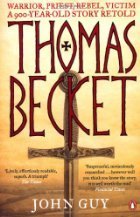
If you ask me Thomas Becket and King Henry II deserved each other - what a pair!
I got this book second hand in a charity shop for 50p and from the cover design had formed the opinion that this was an historical novel - but actually it is a straightforward biography. Oh well, for 50p who cares? It is well written and keeps jogging along at a good pace. The footnotes are kept to a minimum and most of the references to contemporary sources are pushed to the back in an Appendix - which is how I like it, though some may prefer the flow of the text to be constantly broken up with references. The book covers the entire life of Becket and gives a lot of information about which I was not previously aware. It sets the action against the background of the society, Church and politics of the age very well - especially in the first half of the book before Becket becomes Archbishop of Canterbury. It does a good job of explaining enough so that you understand what is going on but without going off down rabbit holes of irrelevant information.
If you are looking for a good introduction to the life and times of Thomas Becket - then this is the book for you.
However, I do have some complaints. The author is very obviously on the side of Thomas Becket and hostile to Henry II. For instance, Becket as "advisers", "supporters" and "assistants" while Henry has "henchmen" and "cronies". When Becket breaks a promise he is driven by a genuine change of mind, but when Henry breaks a promise it is a cynical, sinister trick. After a while I found this relentless bias rather a trial, but I was so far into the book by then that I thought I might as well finish.
At this distance in time, it is very difficult to work out who was right and who was wrong in the basic dispute between Henry and Becket - that is the boundary between Royal and Church authority in society and constitutional terms. The author does not make much effort to try to unpick this for a modern reader. Again he just assumes that Henry is wrong and Becket is correct. Though from the little he does say it seems clear that at the time people disagreed on the issue. It seems that Henry was trying to put the clock back 30 or 40 years time to when the balance of power lay with Royal government, while Becket was trying to push through new reforms that favoured the Church.
The second half of the book concentrates exclusively on the dispute between Henry and Becket. It has nothing at all to say about other aspects of Becket's life nor his role as Archbishop of Canterbury. This is a shame as the medieval church was a powerful, wealthy and proactive organisation that did much to address social issues and moral issues. It would have been nice to have learned something about that.
What comes across in this book - whether the author intends it or not - is that both Henry and Becket were difficult men to deal with. While the author does his best to paint Becket in as positive a light as he can, there is no disguising the fact that any other prelate would have done a deal with Henry. Nor can it be disguised that Becket was an astonishingly tactless, rude and argumentative character. Nobody deserves to be murdered, but if ever a man deserved a slap - it was Becket.

Published on May 13, 2020 04:23
May 11, 2020
Belts from the Attic
During the Corona Virus lockdown, I did various jobs about the house. One was to sort out the attic. I found an old box that I had forgotten about entirely. It contained old clothes that had belonged to my father, but which were too small for me to fit into. They were too worn for sending to a charity shop, and I could never bring myself to throw them away as they were all top quality gear. So they went into the attic. I'll be posting about some of these as we go along.
Among the various items in the box were a number of belts. My father had loved fancy accessories - he often wore a cravat rather than a tie with his suit. He liked to wear fancy belts as well. These are all quite wide so they don't fit through the belt loops of many of my trousers. Did trousers have wider belt loops 50 years ago? I don't know. What I do know is that my father was slimmer than I am, so most of these don't fit me. Never mind, let's have a look at them.
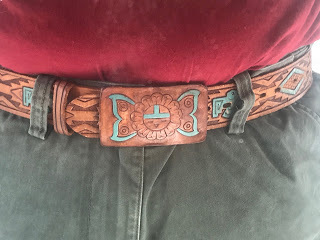 We'll start with this one. It is the only one that I can get to do up on me, so I'm modelling this one for you. On the back my father has written "Albuquerque 1970". My father did a lot of business out in the USA. Sometimes when he went he would add a week or two to the trip to do some sightseeing. I remember a few bits and pieces. For instance I recall that this belt came from some Navajo craft store that he visited. I remember it because he bought me a wallet with the same sort of embossed and painted decoration on it. It was the first grown-up wallet I ever had, and I used it until it fell to pieces, so it was good to rediscover this belt.
We'll start with this one. It is the only one that I can get to do up on me, so I'm modelling this one for you. On the back my father has written "Albuquerque 1970". My father did a lot of business out in the USA. Sometimes when he went he would add a week or two to the trip to do some sightseeing. I remember a few bits and pieces. For instance I recall that this belt came from some Navajo craft store that he visited. I remember it because he bought me a wallet with the same sort of embossed and painted decoration on it. It was the first grown-up wallet I ever had, and I used it until it fell to pieces, so it was good to rediscover this belt.
My father said that when he went into the travel agent in New York to book his flight to Albuquerque, the man there stared at him in surprise and said "I hope you have a good reason for going. There's nothing there!"
Anyway, a cracking leather belt. The leather is raw on the back and is rather stiff with age. But I like the design, so I'm wearing it as I write this.
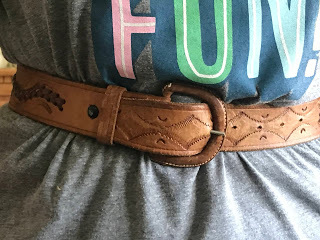
The rest of the belts are too small for me, so they are being modelled by my teenage daughter. This one is very soft, supple leather. On the back is written "Tombstone", but there is no date. My father loved old Western movies. I think I watched pretty much every John Wayne western that came on TV with him. I know that he went to Tombstone once to visit the site of the Gunfight at the OK Coral - the subject of several movies. I suppose he bought this one then. But to be honest, I don't recall this belt at all.
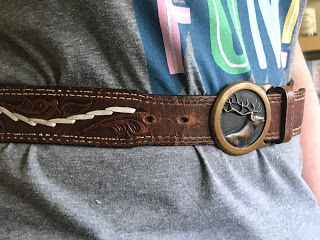 Now, I remember this belt very well as my father wore it a lot. Dad brought it back from one of his business trips to the USA - but I can't recall where or when he bought it. There is nothing written on it, so I can't tell you anything about it. However, my daughter likes it, so she has kept it and is wearing it as a fashion item. How the world turns!
Now, I remember this belt very well as my father wore it a lot. Dad brought it back from one of his business trips to the USA - but I can't recall where or when he bought it. There is nothing written on it, so I can't tell you anything about it. However, my daughter likes it, so she has kept it and is wearing it as a fashion item. How the world turns!
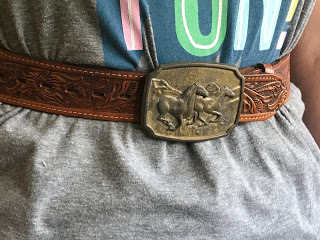 Now this belt I do not remember at all. And although it is old and stiff with age it does not look as if it has been worn at all. Maybe my father did not wear it much. On the back is written "Cheyenne Frontier 1974". I think this must mean it was bought at the Cheyenne Frontier Days rodeo festival that is held in the city of Cheyenne, Wyoming, every July. I suppose the wild horses on the buckle would fit in with that.
Now this belt I do not remember at all. And although it is old and stiff with age it does not look as if it has been worn at all. Maybe my father did not wear it much. On the back is written "Cheyenne Frontier 1974". I think this must mean it was bought at the Cheyenne Frontier Days rodeo festival that is held in the city of Cheyenne, Wyoming, every July. I suppose the wild horses on the buckle would fit in with that.
I remember that my father told me of an event that happened one time he was in a Western cowboy town - maybe it was in Cheyenne. Dad was driving around in a hired car trying to find a particular address but could not do so. He saw a policeman standing in the middle of a road junction directing traffic. He pulled up and asked the policeman for directions. "Gee", replied the cop. "Are you British?"My father said he was. "Do you know a place called Norwich?" asked the cop. "I was stationed on an air base near there during war."Now, as it happens, my father was in RAF Bomber Command during the war. Soon he and the policeman were chatting away about the war, bombing Germany and all sorts of nostalgia. Suddenly the cop stopped talking and looked around. "You'd better get a move on," he said to my father. "We've got ourselves a small problem." My father looked around to see that all four streets leading to the road junction were snarled up with enormous traffic jams. What amazed him was that nobody was hooting or shouting or anything. They were all just sitting there in their cars and trucks patiently waiting for the policeman to stop talking to my dad. The cop gave my dad directions where to go and off drove my dad.
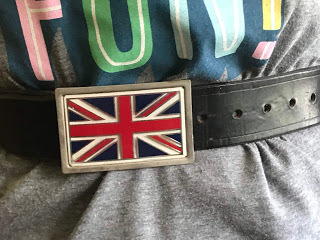 Now this last belt is very definitely not from the USA. There is nothing written on it at all and I can't say that I remember it. It does look like a Carnaby Street item from the 1960s or 1970s to me. But who knows.
Now this last belt is very definitely not from the USA. There is nothing written on it at all and I can't say that I remember it. It does look like a Carnaby Street item from the 1960s or 1970s to me. But who knows.
Anyway, those are all the belts that were in the box in the attic. But there were other clothing items stashed away - I'll write about them later.
You can find out more about Albuquerque HERE
You can learn more about the Navajo, including their arts & crafts, HERE
You can find out more about the Gunfight at the OK Coral HERE
You can find out more about Cheyenne Frontier Days HERE
You can find out more about Carnaby Street HERE

Among the various items in the box were a number of belts. My father had loved fancy accessories - he often wore a cravat rather than a tie with his suit. He liked to wear fancy belts as well. These are all quite wide so they don't fit through the belt loops of many of my trousers. Did trousers have wider belt loops 50 years ago? I don't know. What I do know is that my father was slimmer than I am, so most of these don't fit me. Never mind, let's have a look at them.
 We'll start with this one. It is the only one that I can get to do up on me, so I'm modelling this one for you. On the back my father has written "Albuquerque 1970". My father did a lot of business out in the USA. Sometimes when he went he would add a week or two to the trip to do some sightseeing. I remember a few bits and pieces. For instance I recall that this belt came from some Navajo craft store that he visited. I remember it because he bought me a wallet with the same sort of embossed and painted decoration on it. It was the first grown-up wallet I ever had, and I used it until it fell to pieces, so it was good to rediscover this belt.
We'll start with this one. It is the only one that I can get to do up on me, so I'm modelling this one for you. On the back my father has written "Albuquerque 1970". My father did a lot of business out in the USA. Sometimes when he went he would add a week or two to the trip to do some sightseeing. I remember a few bits and pieces. For instance I recall that this belt came from some Navajo craft store that he visited. I remember it because he bought me a wallet with the same sort of embossed and painted decoration on it. It was the first grown-up wallet I ever had, and I used it until it fell to pieces, so it was good to rediscover this belt. My father said that when he went into the travel agent in New York to book his flight to Albuquerque, the man there stared at him in surprise and said "I hope you have a good reason for going. There's nothing there!"
Anyway, a cracking leather belt. The leather is raw on the back and is rather stiff with age. But I like the design, so I'm wearing it as I write this.

The rest of the belts are too small for me, so they are being modelled by my teenage daughter. This one is very soft, supple leather. On the back is written "Tombstone", but there is no date. My father loved old Western movies. I think I watched pretty much every John Wayne western that came on TV with him. I know that he went to Tombstone once to visit the site of the Gunfight at the OK Coral - the subject of several movies. I suppose he bought this one then. But to be honest, I don't recall this belt at all.
 Now, I remember this belt very well as my father wore it a lot. Dad brought it back from one of his business trips to the USA - but I can't recall where or when he bought it. There is nothing written on it, so I can't tell you anything about it. However, my daughter likes it, so she has kept it and is wearing it as a fashion item. How the world turns!
Now, I remember this belt very well as my father wore it a lot. Dad brought it back from one of his business trips to the USA - but I can't recall where or when he bought it. There is nothing written on it, so I can't tell you anything about it. However, my daughter likes it, so she has kept it and is wearing it as a fashion item. How the world turns! Now this belt I do not remember at all. And although it is old and stiff with age it does not look as if it has been worn at all. Maybe my father did not wear it much. On the back is written "Cheyenne Frontier 1974". I think this must mean it was bought at the Cheyenne Frontier Days rodeo festival that is held in the city of Cheyenne, Wyoming, every July. I suppose the wild horses on the buckle would fit in with that.
Now this belt I do not remember at all. And although it is old and stiff with age it does not look as if it has been worn at all. Maybe my father did not wear it much. On the back is written "Cheyenne Frontier 1974". I think this must mean it was bought at the Cheyenne Frontier Days rodeo festival that is held in the city of Cheyenne, Wyoming, every July. I suppose the wild horses on the buckle would fit in with that. I remember that my father told me of an event that happened one time he was in a Western cowboy town - maybe it was in Cheyenne. Dad was driving around in a hired car trying to find a particular address but could not do so. He saw a policeman standing in the middle of a road junction directing traffic. He pulled up and asked the policeman for directions. "Gee", replied the cop. "Are you British?"My father said he was. "Do you know a place called Norwich?" asked the cop. "I was stationed on an air base near there during war."Now, as it happens, my father was in RAF Bomber Command during the war. Soon he and the policeman were chatting away about the war, bombing Germany and all sorts of nostalgia. Suddenly the cop stopped talking and looked around. "You'd better get a move on," he said to my father. "We've got ourselves a small problem." My father looked around to see that all four streets leading to the road junction were snarled up with enormous traffic jams. What amazed him was that nobody was hooting or shouting or anything. They were all just sitting there in their cars and trucks patiently waiting for the policeman to stop talking to my dad. The cop gave my dad directions where to go and off drove my dad.
 Now this last belt is very definitely not from the USA. There is nothing written on it at all and I can't say that I remember it. It does look like a Carnaby Street item from the 1960s or 1970s to me. But who knows.
Now this last belt is very definitely not from the USA. There is nothing written on it at all and I can't say that I remember it. It does look like a Carnaby Street item from the 1960s or 1970s to me. But who knows.Anyway, those are all the belts that were in the box in the attic. But there were other clothing items stashed away - I'll write about them later.
You can find out more about Albuquerque HERE
You can learn more about the Navajo, including their arts & crafts, HERE
You can find out more about the Gunfight at the OK Coral HERE
You can find out more about Cheyenne Frontier Days HERE
You can find out more about Carnaby Street HERE

Published on May 11, 2020 04:11



